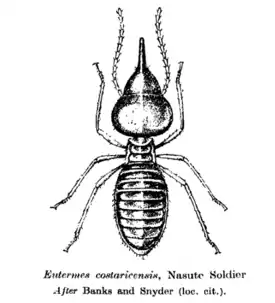Nasutitermitinae
Nasutitermitinae (лат.) — крупнейшее подсемейство термитов из семейства Termitidae. Около 600 видов[2].
| Nasutitermitinae | ||||||||||||
|---|---|---|---|---|---|---|---|---|---|---|---|---|
 Солдат Nasutitermitinae | ||||||||||||
| Научная классификация | ||||||||||||
|
Домен: Царство: Подцарство: Без ранга: Без ранга: Без ранга: Без ранга: Тип: Подтип: Надкласс: Класс: Подкласс: Инфракласс: Клада: Надотряд: Отряд: Инфраотряд: Семейство: Подсемейство: Nasutitermitinae |
||||||||||||
| Международное научное название | ||||||||||||
| Nasutitermitinae Hare, 1937[1] | ||||||||||||
| Типовой род | ||||||||||||
|
Nasutitermes Dudley, 1890 |
||||||||||||
| ||||||||||||

Распространение
Встречаются, главным образом, в тропиках и субтропиках: Австралия, Афротропика, Неотропика, Неарктика, Ориентальная область, Палеарктика. В материковой Европе их нет, но есть один вид на Канарских островах[2]:
- Nasutitermes canariensis (= Eutermes canariensis Czerwinski, 1901)
Описание
Голова солдат отличается длинным носом-трубочкой (лат. nasus — нос, отсюда и произошло название подсемейства), который служит для распыления химического веществ, отпугивающих врагов (муравьи и другие хищники). Жвалы солдат сильно редуцированные, нефункционирующие. Усики имаго самок и самцов 13—21 члениковые, лабрум шире своей длины. Жвалы имаго сходны с мандибулами рабочих: апикальный зубец левой челюсти варьирует по размеру: короче (Nasutitermes и другие роды) или длиннее (Subulitermes и другие роды), чем слитые 1—2-й маргинальные зубцы. Формула шпор голеней: 2—2—2. Усики солдат — 11—21 члениковые; каста солдат трёх типов: мономорфные, диморфные и триморфные. Термитники разнообразные: почвенные и в древесине, картонные и в чужих гнёздах. Некоторые их надземные насыпные постройки достигают огромных размеров. Например, термитник вида Nasutitermes triodiae (Австралия) может иметь высоту до 5 метров[2][3].
Систематика
77 родов, около 600 видов. Крупнейшее по числу видов и родов подсемейство в составе Termitidae. Часть родов (15) и видов (около 100) недавно были выделены в отдельное подсемейство Syntermitinae. Выделяют две клады (группы родов)[2][4][5][6][7].
- Nasutitermes Group: Ahmaditermes, Ampoulitermes, Antillitermes, Arcotermes, Baucaliotermes, Bulbitermes, Caetetermes, Caribitermes, Ceylonitermes, Coarctotermes, Coendutermes, Constrictotermes, Cortaritermes, Cucurbitermes, Diversitermes, Diwaitermes, Fulleritermes, Grallatotermes, Hirtitermes, Hospitalitermes, Kaudernitermes, Lacessititermes, Leptomyxotermes, Longipeditermes, Muelleritermes, Mycterotermes, Nasopilotermes, Nasutitermes[8], Ngauratermes, Niuginitermes, Obtusitermes, Occasitermes, Parvitermes[9], Peribulbitermes, Rhadinotermes, Roonwalitermes, Rotunditermes, Rounditermes, Sandsitermes, Sinonasutitermes, Tenuirostritermes, Triangularitermes, Trinervitermes, Tumulitermes, Velocitermes, Xiatermes
- Subulitermes Group: Aciculitermes, Afrosubulitermes, Agnathotermes, Angularitermes, Anhangatermes, Araujotermes, Atlantitermes[10], Australitermes, Ceylonitermellus, Convexitermes, Coatitermes, Cyranotermes, Eleanoritermes, Emersonitermes, Enetotermes, Ereymatermes, Eutermellus, Latisubulitermes, Leucopitermes, Macrosubulitermes, Malagasitermes, Malaysiotermes, Mimeutermes, Occultitrmes, Oriensubulitermes, Paraconvexitermes, Periaciculitermes, Postsubulitermes, Sabahitermes, Spatulitermes, Subulioiditermes, Subulitermes, Tarditermes, Verrucositermes
Примечания
- Hare, L. 1937: Termite phylogeny as evidenced by soldier mandible development. Annals of the Entomological Society of America, 37(3): 459–486.
- Krishna, Kumar.; Grimaldi, David A.; Krishna, Valerie.; Engel, Michael S. 2013. Treatise on the Isoptera of the world. — Bulletin of the American Museum of Natural History, no. 377: pp.1-2704 (vol. 1-7). ISSN 0003-0090
- Prestwich, G. & M.S. Collins. 1981a. Chemotaxonomy of Subulitermes and Nasutitermes termite soldier defense secretions. Evidence against the hypothesis of diphyletic evolution of the Nasutitermitinae. Biochemical Systematics and Ecology 9(1): 83-88.
- Engel Michael S. Family-group names for termites (Isoptera), redux (англ.) // ZooKeys. — 2011. — Vol. 148. — P. 171–184.
- Reginaldo Constantino. 1995. Phylogeny of the Nasutitermtinae and Revision of the Neotropical Genus Syntermes Holmgren (Isoptera: Termitidae). KU ScholarWorks. The University of Kansas Central American Theses and Dissertations Collection.
- Sen-Sarma, P.K. 1968. Phylogenetic relationship of the termite genera of the subfamily Nasutitermitinae (Isoptera: Termitidae). Oriental Insects 2(1): 1-34.
- Miller, L.R. 1986. The phylogeny of the Nasutitermitinae (Isoptera: Termitidae). Sociobiology 11(3):203-214.
- Miura, T., Y. Roisin, and T. Matsumoto. 2000. Molecular phylogeny and biogeography of the nasute termite genus Nasutitermes (Isoptera: Termitidae) in the Pacific tropics. Molecular Phylogenetics and Evolution 17(1):1-10.
- Rudolf Scheffrahn. (2016). Parvitermes (Isoptera, Termitidae, Nasutitermitinae) in Central America: Two new termite species and reassignment of Nasutitermes mexicanus. — ZooKeys 617: 47-63 (15 Sep 2016) doi: 10.3897/zookeys.617.10040
- Constantino R., O. F. F. de Souza. 1997. Key to the soldiers of Atlantitermes with a new species from Brazil (Isoptera, Termitidae, Nasutitermitinae). Tropical Zoology. 10:205-213.
Литература
- Bourguignon, T. et al. Towards a revision of the Neotropical soldierless termites (Isoptera: Termitidae): redescription of the genus Anoplotermes and description of Longustitermes, gen. nov. (англ.) // Invertebrate systematics. — 2010. — Vol. 24, no. 4. — P. 357—370. doi: 10.1071/IS10012
- Bergamaschi S., T. Z. Dawes-Gromadzki, A. Luchetti, M. Marini and B. Mantovani. Molecular taxonomy and phylogenetic relationships among Australian Nasutitermes and Tumulitermes genera (Isoptera, Nasutitermitinae) inferred from mitochondrial COII and 16S sequences (англ.) // Molecular Phylogenetics and Evolution. — 2007. — Vol. 45, no. 3. — P. 813-821.
- Sands W. A. (1965). A revision of the termite subfamily Nasutitermitinae (Isoptera, Termitidae) from the Ethiopian region. — Bulletin of the British Museum (Natural History) Entomology Suppl 4 pages 1—172.
Ссылки
- Nasutitermitinae (англ.) (недоступная ссылка). termite-control.com. Дата обращения: 18 июня 2013. Архивировано 19 июня 2013 года.
- The Nasutitermitinae termites (англ.) (недоступная ссылка). TermiteWeb. Дата обращения: 18 июня 2013. Архивировано 19 июня 2013 года.
- Termitidae (англ.) (недоступная ссылка). bugguide.net. Дата обращения: 18 марта 2011. Архивировано 19 апреля 2012 года.
- Termitidae (англ.) (недоступная ссылка). Tree of Life. Дата обращения: 18 марта 2011. Архивировано 19 апреля 2012 года.
